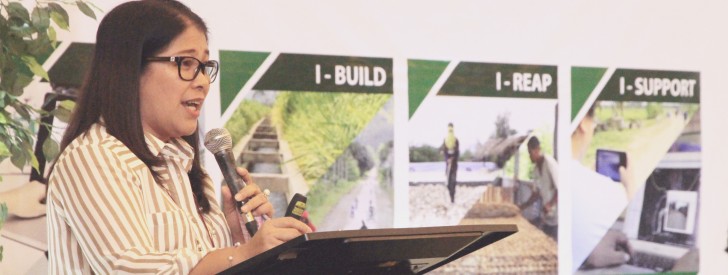 Davao del Norte Provincial Project Management and Implementing Unit Head Josie Jean Rabanoz shares how their province has become more competitive as skills and capacities of local planners and designers were enhanced with the use of PRDP tools during the World Bank First Implementation Support Mission to the PRDP in Mindanao cluster on September 8, 2015 in Cagayan de Oro City. (Photo by Gian Enriquez, DA-PRDP Mindanao)
Davao del Norte Provincial Project Management and Implementing Unit Head Josie Jean Rabanoz shares how their province has become more competitive as skills and capacities of local planners and designers were enhanced with the use of PRDP tools during the World Bank First Implementation Support Mission to the PRDP in Mindanao cluster on September 8, 2015 in Cagayan de Oro City. (Photo by Gian Enriquez, DA-PRDP Mindanao) Rural dev’t project drives planning reforms in Mindanao LGUs
Planning reforms in Mindanao are underway as the national government and the provincial local government units continue to partner for the implementation of the Philippine Rural Development Project (PRDP) in the island region.
The PRDP, a six-year agricultural development initiative implemented by the Department of Agriculture (DA) with funding assistance from the World Bank, has engaged LGUs around the country, including those from Mindanao, to arrive at evidence-based decisions to develop their respective agro-fisheries sectors.
During the World Bank First Implementation Support Mission to the PRDP in Cagayan de Oro City, Brigida Tangonan, head of the Lanao del Norte Provincial Project Management and Implementing Unit (PPMIU) highlighted how their province had been able to improve their planning methodologies for agri-fishery sub-projects when they engaged in the PRDP.
Tangonan said that planners and implementers in the local government were capacitated in crafting their Provincial Commodity Investment Plan (PCIP), as well as feasibility studies, which are needed to propose sub-projects under the PRDP.
Promoting planning reforms among LGUs
A PCIP is a strategic three-year rolling plan containing possible interventions to be undertaken by a province for priority commodities in support of the national Agriculture and Fisheries Modernization Plan (AFMP) and the localized regional AFMP. Under the PCIP, these interventions shall be implemented in collaboration with the DA Regional Office, concerned government agencies and private stakeholders, including those with agribusiness interest.
According to PRDP National Project Director and DA Undersecretary Emerson Palad, an LGU should first prepare a PCIP before the PRDP management approves its sub-project proposals.
The PCIP is based on another tool utilized by the PRDP—the Value Chain Analysis (VCA) used to assess the status and the linkages and interplay of the different value chain players of a particular industry. The results of the assessment will then be used to identify appropriate upgrading strategies and interventions that will contribute to the development and strengthening of the subject industry’s competitive advantage.
“We cannot proceed with [the] PCIP, if there is no existing VCA,” Tangonan said.
This way, the PRDP assures that all sub-projects implemented under the Project are based on the actual needs of the commodity in particular areas, and will address constraints in the value chain.
Aside from the PCIP and VCA, LGUs participating in the PRDP also utilize the Expanded-Vulnerability Assessment Tool (E-VSA), an online tool which takes into account both agro-climatic data, and socio-economic indicators such as poverty magnitude and incidence, number of farmers and fishers and size of production area, among others as bases in targeting interventions and formulating strategies for investments.
“With the E-VSA, we were able to come up with municipalities of Tubod, Lala, and Capatagan as our priority areas for the coconut-based sub-projects proposed under the PRDP,” Tangonan explained.
As of September 17, 2015 Lanao del Norte has a project portfolio of more than P266.58 million, one of which is the Integrated Coconut-Based Enterprise in Tubod, Lanao del Norte. The World Bank consultants and DA-PRDP implementers visited the project site during the implementation support mission.
Davao del Norte PPMIU Head Josie Jean Rabanoz shared that their province has become more competitive as skills and capacities of local planners and designers were enhanced with the use of PRDP tools.
“With the crafting of PCIP, all components engaged in the project maintained close coordination and constant communication, which is key to a streamlined implementation of [the] PRDP in the local government,” Rabanoz added.
Davao del Norte has as a total project portfolio worth P1.19 billion under the PRDP, of which four farm-to-market roads have already been approved for funding.
Holistic development through the PRDP
“Aside from helping the local governments achieve complete development in the rural areas through provision of grants, we also want to capacitate the local governments in planning and implementing agri-fishery sub-projects,” Palad said.
The PRDP covers 90% of total project cost for infrastructure sub-projects and 80% for enterprise development sub-projects. The rest of the project cost is shouldered by the LGU and proponent groups as equities.
The Undersecretary also said that as LGUs are receptive of the PRDP, the DA recognizes that there is a need for the Department to beef up coordination mechanisms with its LGU partners so that they can adhere to the important guidelines and requirements set by Project.
“By the end of the Project, we want all our innovations and mechanisms mainstreamed both in the national government and local governments,” Palad added.
The PRDP, the government’s main platform for rural development, aims to improve rural economy by operationalizing local-level convergence among agricultural stakeholders, synergizing programs and projects for modern, climate-smart and market-oriented agri-fishery sector that benefits the greater segment of farmers and fishers. (Catherine Nanta, DA-PRDP)
